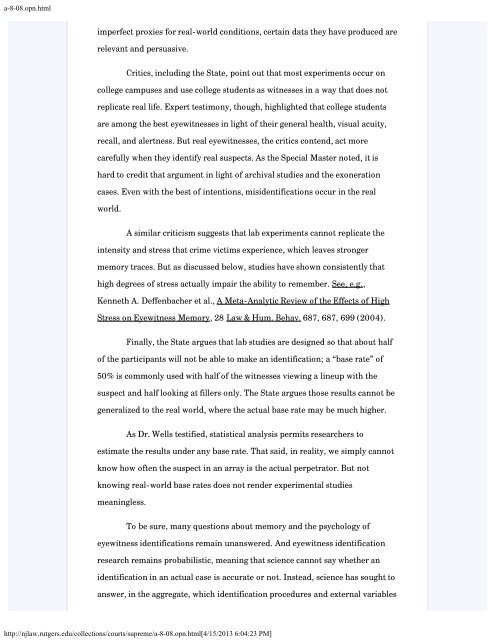State v. Henderson and the New Model Jury Charges - New Jersey ...
State v. Henderson and the New Model Jury Charges - New Jersey ...
State v. Henderson and the New Model Jury Charges - New Jersey ...
Create successful ePaper yourself
Turn your PDF publications into a flip-book with our unique Google optimized e-Paper software.
a-8-08.opn.html<br />
imperfect proxies for real-world conditions, certain data <strong>the</strong>y have produced are<br />
relevant <strong>and</strong> persuasive.<br />
Critics, including <strong>the</strong> <strong>State</strong>, point out that most experiments occur on<br />
college campuses <strong>and</strong> use college students as witnesses in a way that does not<br />
replicate real life. Expert testimony, though, highlighted that college students<br />
are among <strong>the</strong> best eyewitnesses in light of <strong>the</strong>ir general health, visual acuity,<br />
recall, <strong>and</strong> alertness. But real eyewitnesses, <strong>the</strong> critics contend, act more<br />
carefully when <strong>the</strong>y identify real suspects. As <strong>the</strong> Special Master noted, it is<br />
hard to credit that argument in light of archival studies <strong>and</strong> <strong>the</strong> exoneration<br />
cases. Even with <strong>the</strong> best of intentions, misidentifications occur in <strong>the</strong> real<br />
world.<br />
A similar criticism suggests that lab experiments cannot replicate <strong>the</strong><br />
intensity <strong>and</strong> stress that crime victims experience, which leaves stronger<br />
memory traces. But as discussed below, studies have shown consistently that<br />
high degrees of stress actually impair <strong>the</strong> ability to remember. See, e.g.,<br />
Kenneth A. Deffenbacher et al., A Meta-Analytic Review of <strong>the</strong> Effects of High<br />
Stress on Eyewitness Memory, 28 Law & Hum. Behav. 687, 687, 699 (2004).<br />
Finally, <strong>the</strong> <strong>State</strong> argues that lab studies are designed so that about half<br />
of <strong>the</strong> participants will not be able to make an identification; a “base rate” of<br />
50% is commonly used with half of <strong>the</strong> witnesses viewing a lineup with <strong>the</strong><br />
suspect <strong>and</strong> half looking at fillers only. The <strong>State</strong> argues those results cannot be<br />
generalized to <strong>the</strong> real world, where <strong>the</strong> actual base rate may be much higher.<br />
As Dr. Wells testified, statistical analysis permits researchers to<br />
estimate <strong>the</strong> results under any base rate. That said, in reality, we simply cannot<br />
know how often <strong>the</strong> suspect in an array is <strong>the</strong> actual perpetrator. But not<br />
knowing real-world base rates does not render experimental studies<br />
meaningless.<br />
To be sure, many questions about memory <strong>and</strong> <strong>the</strong> psychology of<br />
eyewitness identifications remain unanswered. And eyewitness identification<br />
research remains probabilistic, meaning that science cannot say whe<strong>the</strong>r an<br />
identification in an actual case is accurate or not. Instead, science has sought to<br />
answer, in <strong>the</strong> aggregate, which identification procedures <strong>and</strong> external variables<br />
http://njlaw.rutgers.edu/collections/courts/supreme/a-8-08.opn.html[4/15/2013 6:04:23 PM]
















